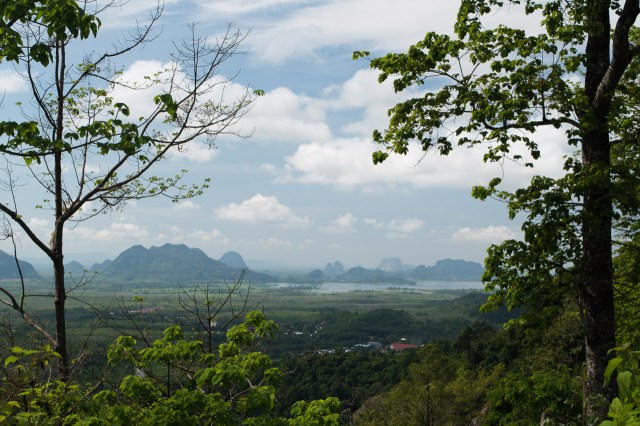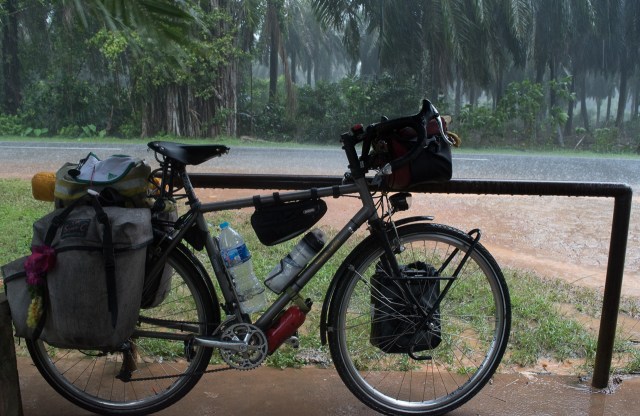Along the jungle road and across the Malaysian border and we’ve left behind Thailand’s hotpants, obesity crisis and nasal sing song, where intonation is everything. The differences are sudden and quite stark.

The Malaysians often wear more, especially the ladies, dressed head to foot in something voluminous and Islamically modest. Many men wear little pill caps, as we’ve seen before in the ‘stans’ and a few places in India. It’s not universal though – there are still shirtless men in rural areas, and hotpants in towns. Malaysia is a predominantly Moslem country, compared to Buddhist Thailand, although as we saw later it has very substantial non-moslem minorities. There are many mosques, but also numerous Chinese Buddhist temples, Indian Hindu temples and some churches.
On the road, Thailand’s population of 8 motorbikes and 2 pickups in every 10 vehicles is replaced, unfortunately, with a more European mix: lots of cars. It makes the roads feel a lot more cramped and dangerous, although the driving is nothing to complain about.
Trying to avoid the main roads has lead to some delightful routes along minor coastal roads and weaving across the plentiful lanes dissecting the numerous and expansive paddy fields; water monitors to the left, water monitors to the right. Occasionally one has scampered ahead of us before taking the plunge.
As we progressed south it became more difficult to avoid the ‘principle highways’ full of roaring traffic especially as we were all squeezed between the mountains and around the many inlets and rivers. At one point, two of our three electronic navigation devices said, ‘No’, to a way across the river avoiding a main road but Maps.me clearly showed there is a passage. At lunch we quizzed a local guy who spoke reasonable English but he was not interested in the idea of a river crossing. Nothing on the other side except palm plantations, he said, and was clearly in favour of the main road up and round the inlet.
An inner glow welled up inside me, on the other side is a palm plantation: small lanes, no traffic, trees for cover. It couldn’t be better! But did a ferry exist, as there evidently wasn’t a bridge? We set off with our fingers crossed. 1.5 km wasn’t too far to go to find out. As we rounded the corner onto the waters edge the ramp on the other side was clearly visible. Flapping arms directed us further along the road where we came upon an opening between workshops and boat houses. Initially it didn’t look too promising but tucked in at the edge of this broad, rope-strewn slipway was a rickety jetty with a short, dumpy, roof topped boat with a section cut out of its side – the ferry. In a jiff we’d jiggled the bikes across the random, ill fitting planks of the gang way, through the hole onto the ferry, to the amusement of the folks already on board with their small motorbikes lined up ready to go.
There’s a lot of unhappiness worldwide about the way the rainforests are being cut down and replaced with palm oil plantations. Malaysia is a prime example. The same comments probably apply to the old rubber plantations too, and coconut palms. But although they’re undiverse compared to rainforest, they’re not so bleak. Other plants and trees crowd the edges of tracks and irrigation ditches, we see monitors, monkeys and squirrels. Brahminy kites and crested serpent eagles patrol the treetops, while purple herons and kingfishers line the ditches.
After all our careful planning the South Westerly monsoon has come as a bit of a surprise. Cycling in it has thrown up new challenges. We’ve always attempted to set off early each morning but regularly fail (Gideon sez that’s not a new game, we played it with sea kayaks too). Now there is further motivation. Not infrequently, as the day progresses the black thunder clouds chase us along the roads, the rumbling of thunder close behind, snapping at our heels. The first drops of rain quickly develop into rigid rods beating down upon our backs. Heads low peering forwards as we spy for somewhere to cower; we’ve been remarkably lucky at finding shelter. Mindful of the time however, eventually we have to grit our teeth and set off again. Cars whizz past through newly formed pools and suddenly we’re wearing them. It’s warm of course, but the soggy shorts chafe. Bikes gears and brakes pick up destructive grit and grime.

Our first stop was at Georgetown, a UNESCO listed ex-colonial town on Penang island. Penang was British long before Malaysia’s sultanates fell under the control of the East India Co. or the empire. The island was nominally uninhabited when the sultan offered it, in 1786, to the East India Company in exchange for protection from Siam (which the EIC failed to provide). The EIC brought in a lot of South Indian labour, whose descendants are still running microcosms of India all over the state, and attracted a lot of Chinese, who to this day are the largest ethnic group in Georgetown. It seems quite often in Malaysia that the ethnic mix, and therefore culture, in the cities, is quite different from the country, which is more Malay, and more Islamic.
Whilst I found it fascinating that in such a small area it was possible to find half a dozen architectural styles of shop-houses spanning 300 years it was the clan jetties that captured my imagination most. From cargo landing jetties to the addition of cargo stores to workers shelters to family/clan residences in a little over a hundred years. Built on stilts at the waters edge they cunningly avoid the land tax. Today they sit at the base of immaculate white towering sky scrapers making an awkward mix between old and new. Each clan jetty traces its origins – and the origins of its inhabitants – to a particular province/region in China.
Alas, while on a bus up the coast of Penang, thieves struck, and Gideon’s phone and bank card were stolen. Gideon spent the next couple of hours using Clare’s phone to lock out the old one, change passwords, and call the bank. It was easy enough to replace the phone nearby, and there was little data on it that wasn’t stored online. A new bank card was ordered, which, thankfully, Hailey sent out to our planned Singapore stop. The only ongoing difficulty after a few days was the loss of the UK SIM card, which unfortunately being Vodafone, meant hours and hours of meaningless and useless “customer service” before establishing that probably it couldn’t be replaced without visiting their shops in the UK. The other loss was the really nice phone case I’d made myself – the new phone has to make do with a batik souvenir one, helpfully modified by a little India tailor.
From Georgetown south along the west coast, the Malaysian peninsula is populated and urbanised. The lengthways hills limit the small road options. Little gems like Pontian Kecil, which still encapsulate the Malaysian seafaring and fishing heritage, are few and far between, without unwanted detours. Still, it was our choice, to avoid the hilly Cameron Highlands in the middle, and if we hadn’t wanted to see the cities, the quieter east coast was available. So the cycling latterly has been a bit crap, even though Malaysian drivers are generally slower and more considerate than British ones.
Our second stop in Malaysia was the capital, Kuala Lumpur. With over 7 million souls in its greater area, it is around the 50th biggest city in the world. We’ve increasingly been using Travelfish for city information, as it’s helpfully concise. In this case, it directed us to Chinatown, where we easily found a cheap and comfy hotel. When we strode out in the morning, we stumbled over a good selection of the city’s sights.
British Empire architects seem to have enjoyed themselves with Mughal styles and motifs. These Edwardian low rises are now at the foot of steel and glass towers, many of which, again, refer to Islamic forms. Weaving around the buildings is a modern throng of international people appearing from busy roads, pavements, metro system, monorail. The heat outdoors under the sun is intense, but tall buildings provide shade; shops, malls, hotels and up-market restaurants compete to impress with their sophisticated air conditioning.
Melaka (Malacca) was our final stop in Malaysia. Unlike our other halts, it seemed single-mindedly a tourist town, and little else. Being the weekend it was crowded with tourists from KL and Singapore, pushing the already high prices up a notch or two. A one day dash was sufficient to see yet more notable houses of worship, China town, the Jonker Walk night market and, from multiple other choices, we ventured into the maritime museum. A smaller version of Nelson’s Victory provided the setting for an informative trail through the passage of time in Malaysian sea faring.
Some very pretty cycle rickshaws in Melaka, each with a sound and light show.
After Malaysia, to the city-state of Singapore, a simple bridge/border crossing, no visa complications, and one of the wealthiest places in the world.

































































Hi Clare and Gid – very interesting post, but am wondering why the title is 7934?
LikeLike
Hi Dave, great to hear from you. I think we had failed to give it any title so there must have been a reason that WordPress assigned it those numbers. Thank you for pointing it out; it now has a title. We’re still on course for a last section across America later this year but now ‘have’ to do more miles. Jason, whom we met in Bangkok, told us that in the Guiness Book of records a RTW trip had to be 18000 miles. Our trip was going to be in the region of16500. Well, that’s no good is it! So we’re seeing where we can get that extra 16000 miles from. A longer route across both Australia and America are obvious starting points but still hoping you’ll join us somewhere in America. Clare xx
LikeLike
Hi Clare – the RTW rules also mentions including Antipodal points (such as Wellington, New Zealand and Northern Spain)- that may give you the extra distance also. Yes, very keen to join you and Gid somewhere on your American leg. Dave x
LikeLike
Sorry for delay replying, Dave, was researching. I doubt we could meet the antipodal requirement. We decided quite a while back to skip NZ, on a cost/benefit basis.
LikeLike